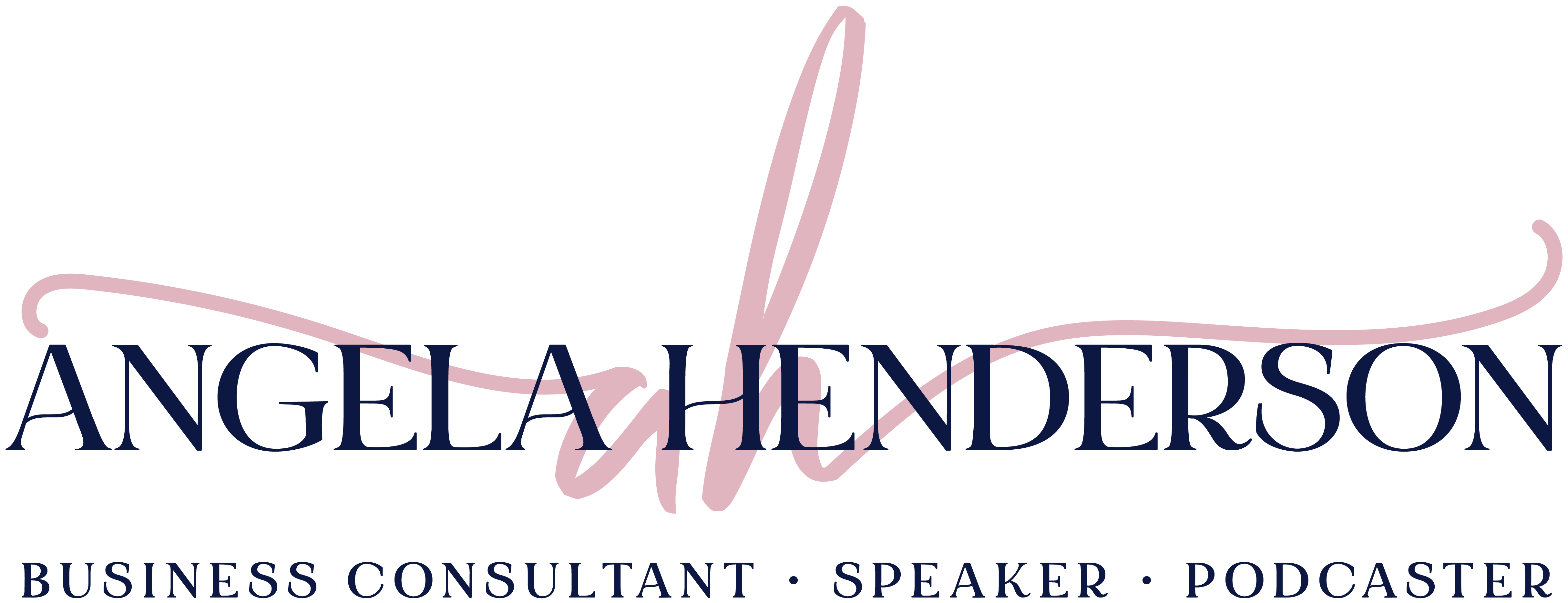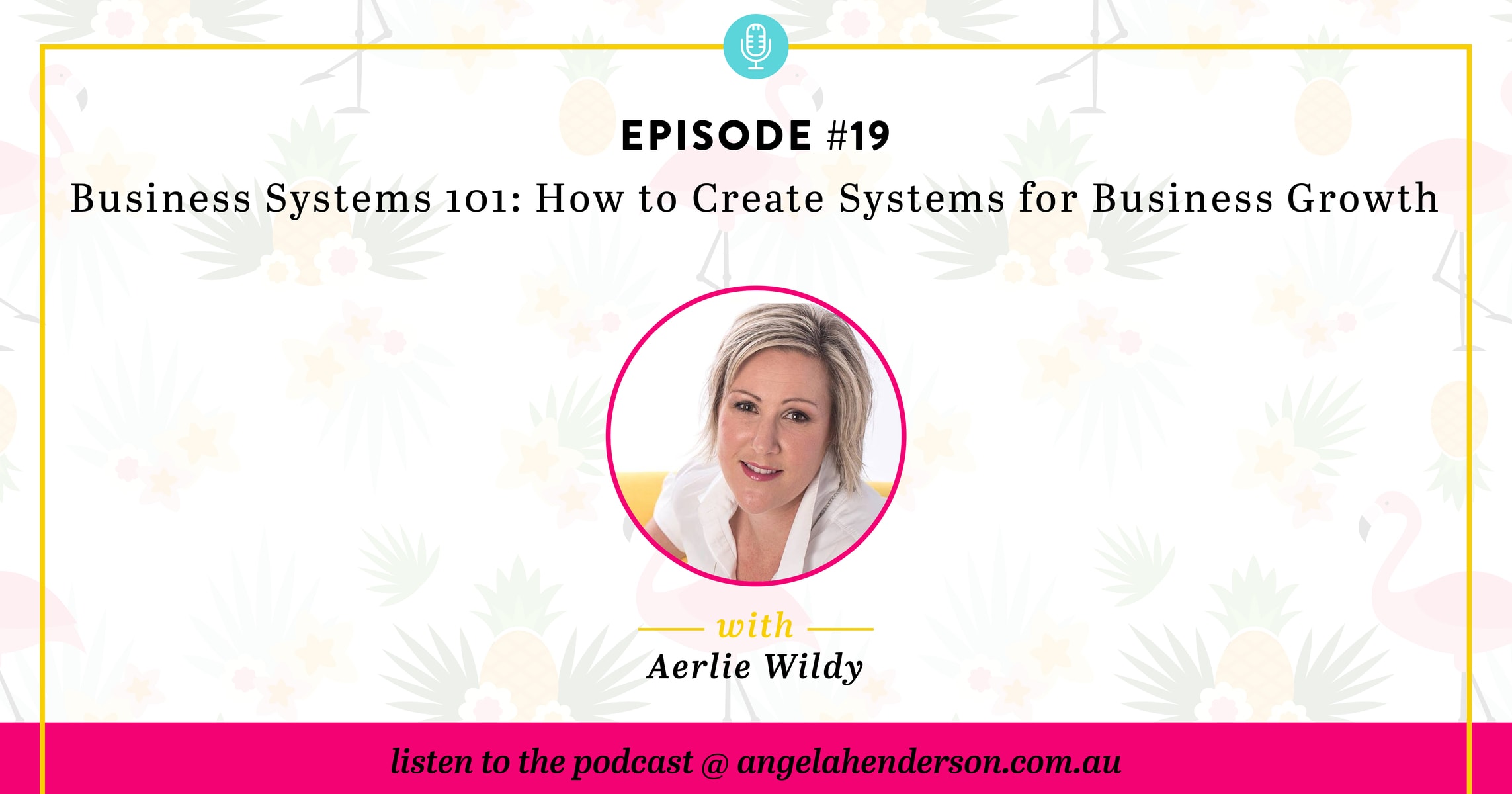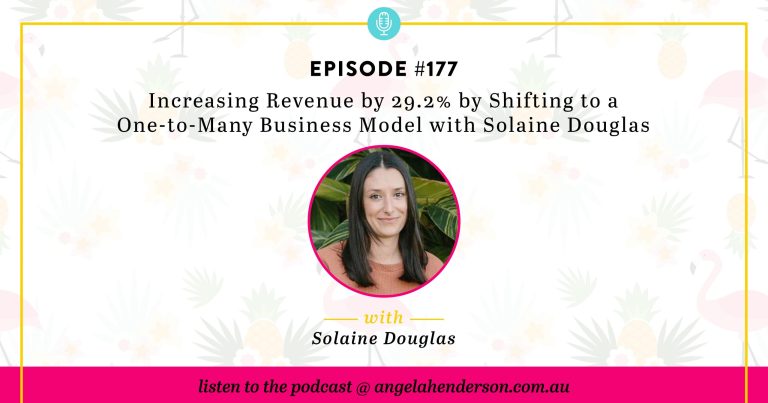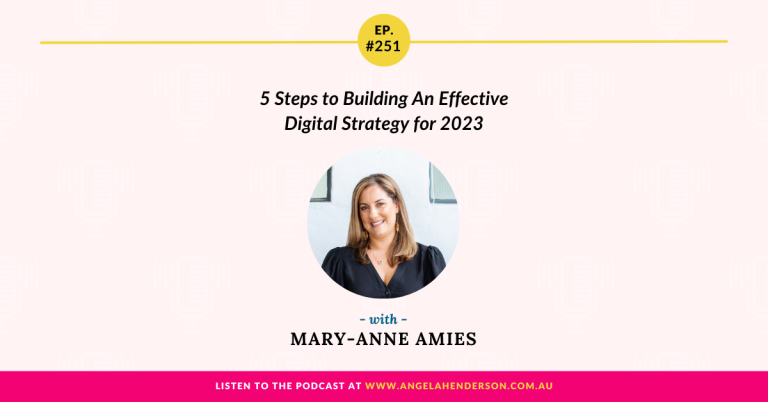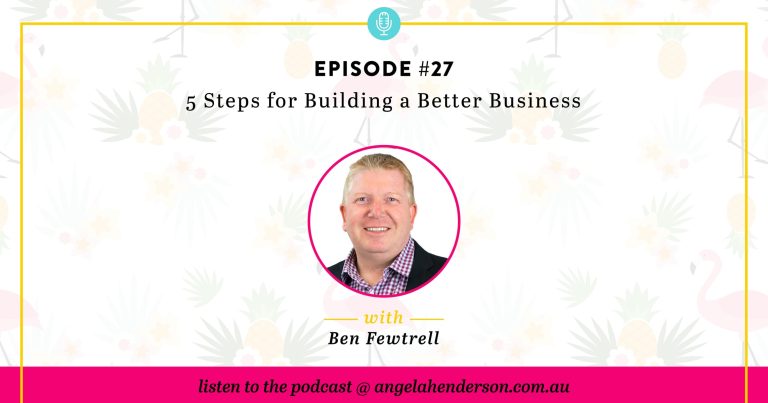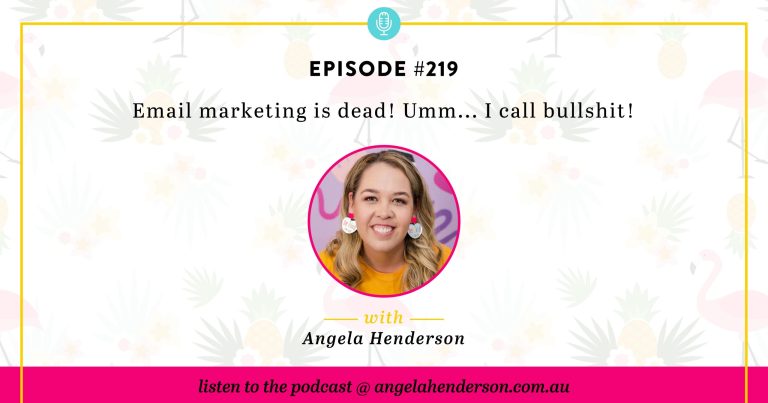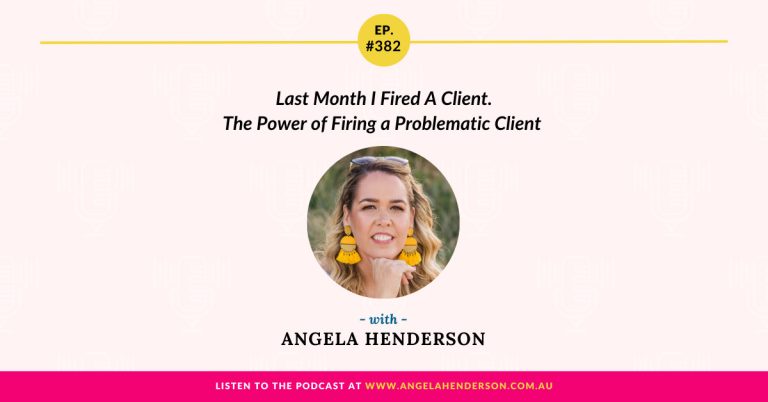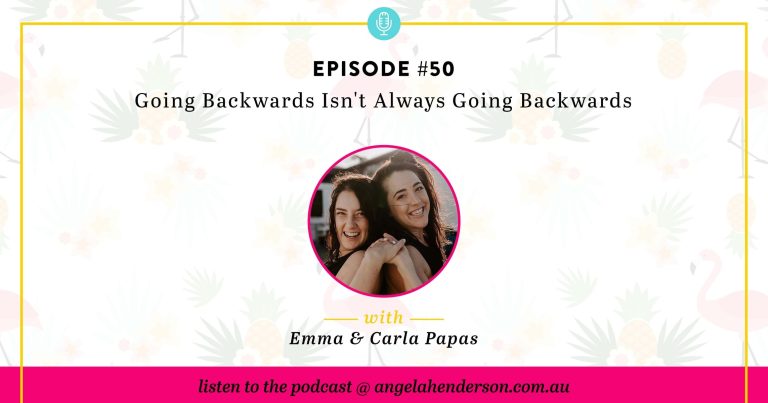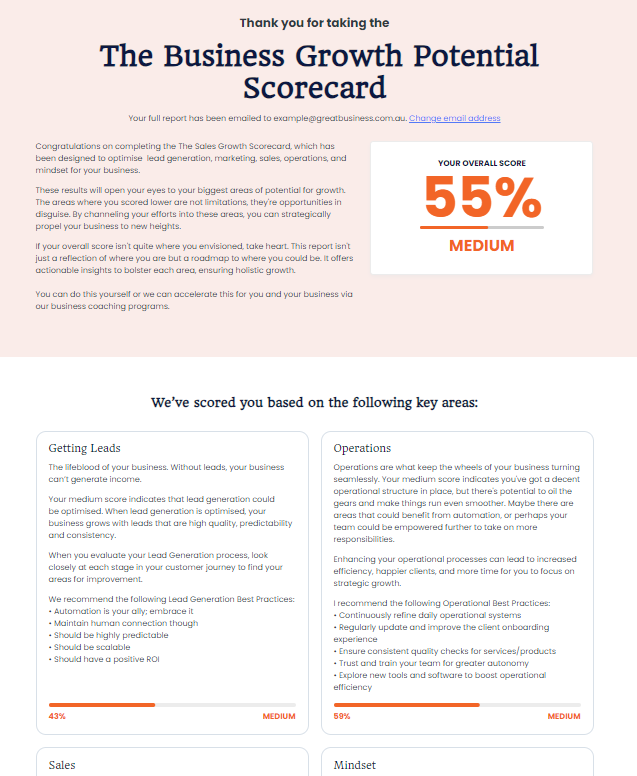Aerlie Wildy, an Online Organization Coach and Systems Strategist, joins us today to talk about creating business systems for growth and success. We discuss the types of systems we need, why we need it and how it can help our business. She also shares with us the Top 5 system tools that you can start using today to help put systems in place for your business to grow.
Important Links Mentioned in the Show:
Angela Henderson Active Business Facebook Group
Angela Henderson Facebook Business Page
Prefer to read Business Systems 101: How to Create Systems for Business Growth? Here’s the transcript:
ANGELA:
You’re listening to the Business and Life Conversations podcast, with Angela Henderson, episode 19.
Hey there, you’re listening to the Business and Life Conversations podcast, my name is Angela Henderson, and on this show we talk about improving your business, life or both. By having amazing and rich conversations with brilliant guests. Who will inspire you and who will give you tips and tricks, to help you grow both in life and in business.
Hello, hello, amazing humans. It’s another episode of The Business and Life Conversations podcast with me, your host, Angela from Angela Henderson Consulting. Today, we’re going to have the coolest online organisational coach and system strategist, joining us to talk about the importance of creating systems for your business in order to grow successfully. We’ll chat about why your business needs to be systemised, how do businesses even know what types of systems they need, and also give you, lucky listeners of top five system tools you can start using today to help put systems in place for your business to grow. Welcome to the show, Ellie.
AERLIE:
Hello.
ANGELA:
Hello, hello. How are you today?
AERLIE:
I’m awesome. How are you?
ANGELA:
I’m good, thank you. How’s the weather down in South Australia?
AERLIE:
It’s wild, and windy, and wet.
ANGELA:
Wild, windy, wet. Do you have a fire going, is the main question?
AERLIE:
No, I had the heater on this morning, I’ve turned it off though because I’m toasty warm now.
ANGELA:
You’re toasty warm. All right. I would love to tell you that we are toasty warm under a fire here in Queensland. However, the sun is shining. I could actually talk literally sun baking today.
AERLIE:
That’s enough, that’s enough.
ANGELA:
But I’m in here still in my hoodie. I’m always in the hoodie because I run cold. But anyways that’s a whole other story. So listen, you and I first met last year. Literally it was almost to the day at Tash Corbin’s conference up at the Sunshine Coast. And not only have we become good friends, but I’ve personally have contracted you out to help with creating better systems for my own business, Angela Henderson Consulting. It’s because of these systems that I knew I also had to have you on my Women in Business retreat in November because systems.
I always knew they were important, but obviously once I started working with you, I was like, “Yeah, a lot more people need to know about what you do.” Because I think there’s this false assumption about what systems are or what businesses need and how they all work and then that’s why I brought you on stage because I really want you to open up to the listener about what type of systems they actually need for business growth. Because I think a lot of businesses are stagnant or potentially putting themselves at risk because they don’t have the systems that they need. What are technically crucial for business growth? What do you think? What about that?
AERLIE:
Totally, totally and it can be so confusing for people, there are so many choices like systems. People talk about systems, but it doesn’t have to be confusing. It doesn’t even have to be tech. Systems can be really simple things like a checklist, just to make life easier. I’m all about making life easier because man, we’ve got so much to do as it is.
ANGELA:
And what I love when we work together is that you really focus on what the business needs, but equally what did I have the capacity to understand myself to do. So we prioritise, “Okay, Ange you can do this.” There’s a whole bunch of things we’ve worked on, but you really met me where I was at and there was really, really complex ways we could go, but you really took it back down to the foundations. I’m a big believer about going back to foundations, some of our things where like you said, checklist, put pen to paper. Where other things were a little bit more tech but not too tech where I was scared off and overwhelmed.
I’m super excited to have you on the show today. But before we really hone into this whole system’s ninja moves you’re going to give us, I’d like to you for you to tell us a little bit about you and your business, but also what is your favourite alcoholic drink? Because I do know, I see you occasionally with a few pictures of wine in it. So let’s get down to business, what is your most favourite alcoholic drink?
AERLIE:
In winter, or could be summer as well I would have to say I do like a gin and tonic or some gin from Kangaroo Island. That is just stunning. There’s beautiful gins around that. So yes, that’s a favourite.
ANGELA:
Alright. So once we finished everything up to the Women in Business retreat in November, I will make sure to, yeah, have a gin and tonic ready for you. No worries. I can do that for you. So tell me, why do you think Ellie that it’s so important.. no, actually, let’s go back a little. We’ve just been talking about gin and tonic. We forgot to talk about you. See this, what happens when I’m talking about alcohol? “Go back Angela, focus.” Tell me a little bit about you and your business. So the listeners have a little bit more of a clear understanding.
AERLIE:
So I am a mum. I have two girls that go to school, thankfully across the road, which makes life easier. I work from home and I’m not a naturally organised person. But I know that when I’m at my best, I know the systems are working for me, so I get addicted to making life easier for myself, which does sound a bit weird, but the more time I have hanging out on the couch with a gin and tonic, the better.
ANGELA:
Amen, yes.
AERLIE:
I see so often where systems, it’s like the cogs, they you do the hard work and I do have a natural ability to create structure in all the jobs that I’ve had around the world. I lived in Dubai for a couple of years, in New Zealand and the U.K. and just constantly creating structure and having that structure allows me to go, “Here’s the next step, here’s the next step. This is what you need.” And that’s really my strength I think. So, systems are a natural way for me to then help people grow their business.
ANGELA:
So currently what would you say, what would a day to day thing look for you in business so that listeners can get a view about what you do?
AERLIE:
Would be doing my little system for my morning ritual that I have listed, but prioritising doing, I have to create content or use my brain first, so that by the time it’s afternoon I can do the fluffier stuff like a bit of Facebook. I have a couple of VAs and I do spend most of my time either marketing, creating content or working with clients and that’s an awesome balance that I love.
ANGELA:
So that’s what you do, but what would a typical day look if someone were to pick up the phone and work with you? So again, to go back to when you were working with me. What type of skills or what type of things would you do when you were working with other people?
AERLIE:
It would be getting to know exactly what they’re doing, day to day. Looking at their weekly schedule, looking at what tools they’re using and what their goals are and finding out the gaps. Asking them really important questions. “Are you doing this? What’s getting in the way of you being able to do this”, and brainstorming some ideas. “Well, have you tried this? What if we tried this?” I don’t know, that’s still a bit vague, but everyone is different.
ANGELA:
Exactly right and that’s what I love is that from a systems point you’ve got so many tools covered. But when I guess when you first started working with me, one of the first things we looked at was, “Ange, where can we free you up the quickest and the easiest and one of that thing was is even though I had a word document with all my responses, you were like, “Hold on, you can take it one step further.” And I was like, “What do you mean? I don’t need any help, I’ve already got it done.” And they’re like, “No, there’s this thing called canned responses.” And I was like, “Okay, whatever.” But I was like, “All right, be open to the process.”
So I was open to the process and what it really was is that a canned response is basically just the response that sits in your email, ready to go? You click it and it automatically populates that email. So if you’re having to do the same emails over and over again, instead of even me having to open up my word document, copy and paste, some people will think that that doesn’t take that much time. But the reality was, is this particular canned response is I was doing it literally probably about 10 times a week. So, if I even set two minutes to each task, that’s 20 minutes a week, that’s 80 minutes a month, that’s an hour and 10 minutes that I’ve just freed up by utilising a canned response. So, I guess those are the types of things that you do.
AERLIE:
Efficiency about working out what the process is getting clear, but is there a way we can do that easier? Yeah.
ANGELA:
So why do you think that businesses need to systemise their overall business?
AERLIE:
I think systems allow businesses to have great foundations and it’s really important to have those foundations and because most businesses have grown from an idea and we get to a certain point where we’ve been winging it for.. but you get to be the bottleneck then because there’s only so much one person can do. So having systems in place then allows space to improve so you have the foundations and you improve and that’s a really important cycle for growth and that’s a very simplified explanation, but it’s pretty important.
ANGELA:
And would you also say though that from the point of view, from a systems point that if you’ve got everything in your head and you know everything, that if your kids became sick and you hadn’t had a process done with your VAs because it wasn’t systemised, that potentially you’re putting your business at risk for everything to fall over?
AERLIE:
Massively. And that overwhelm. A lot of entrepreneurs sit in overwhelm mainly because everything is in their head. Just having processes to have the systems out of your head, and again, it can just be three dot points for a system, it doesn’t have to be complicated, but it means that someone else could step in and pick up your business or go in and know what steps to follow to get something done. You could go on holiday with systems, you can’t go on holiday if it’s reliant on you doing the work.
ANGELA:
What would you say is the biggest barrier and one of the main reason why people might be resistant to systems?
AERLIE:
There’s lots of barriers. One is fear of technology. One is learning the technology and the time that’ll take, but when you look at the fact that you can do, setup a system, it might take an hour to set up to get really clear on the process and have it explained and have all the resources and the links and stuff. You do that once. But if you were doing that and it was taking it for writing a blog, for example, and it took you two hours to write it, to draft it, to create the images, to publish it, to schedule it. Two hours every week, that adds up to a lot of time.
ANGELA:
Yes.
AERLIE:
It’s the next step to you being able to outsource and then spend more time doing the work that you love.
ANGELA:
And would you say that also having the systems as part of the overall sales cycle and what I mean by that, for those listeners who are like, “Ange, stop using big words,” but the sales cycle really is, let’s just say, let’s look at a funnel for example, so you bring someone onto a funnel and they’ve signed up for something for free or if they’re signed up for one of your opt-ins, whatever that is, and then they’re just sitting in your newsletter world. They don’t get nurtured or they don’t get touched. By that lack of system being in place, you’re missing out on overall sales.
But I guess if you did have a system in place. If someone signs up for something and then we’ve created an email sequence that welcomes and once they get the free printable or whatever you’ve given them, we then touch base again two days later and then they may go into the general pool of newsletters. You then are always nurturing that system or not that system. You’re nurturing the relationships, so therefore the system’s working for you versus against you. Would you, agree?
AERLIE:
Absolutely. Absolutely. That sales cycle where you create an offer, you need systems, you launch a program, you need systems, you grow your list, you need systems, and then you come back to creating a new offer or improving your offer. You need more systems to scale your business and have capacity for that growth. It’s so important to have that, but having those systems also allows you, they do the hard work for sending the emails and nurturing your people. It allows you more space and time to connect, live on Facebook. It allows you more space to be authentic and to be you because the systems are doing the admin and the work for you.
ANGELA:
And would you say when there is a lack of systems in place, I guess that the people can become stagnant in their business. So yes, there’s still constantly making money. And they still might even be profiting. But the reality of it is that until systems are implemented. It’s going to be very, very hard and crucial really for business to ever scale.
AERLIE:
Yes, yes, definitely. And you know it is hard when you don’t know what you don’t know, but if you’re finding that stagnancy, then looking at ways to create that space so that you can connect, so that you can communicate with your tribe and get that momentum back again. Systems doing the work for you is the way that you’re going to achieve that.
ANGELA:
So there will be some people out there going, “Well that’s great, but how do I us business owners even though what types of systems we need in order to even say contact you, Ellie.” or like you said, we don’t know what we don’t know. So, one example we just touched upon as if you’re becoming stagnant and going, “Why ain’t I growing? What’s going on?” That could be an indicator that you need a system. What are there other key things that businesses would know or how do businesses know that they know that they need a system?
AERLIE:
If they’re being overwhelmed all the time because they’re the bottleneck essentially for all the work has to be done by them and repeating tasks over again, if it’s a repetitive task it can either be automated or you can outsource it. So, having someone come in to look at all those things that you do and go, “Why are you still doing this? You could let this go, set it up and forget it.” So that is something, if you are feeling disorganised, that’s actually, a sign that you need systems in place and structure.
If you sit down at your desk, this is what a lot of people say to me, sit down at your desk and don’t know where to start because there isn’t that just getting clear again on your priorities so that you know what you need to do next and that bigger picture as well as the detail of, “Well, I have to do this and then I have to do this.”
ANGELA:
Like you said that we could talk about systems for hours because each business, as you said, has unique systems that are used daily, weekly, monthly, etc. One of the big things that again is I was in that cycle that you were talking about before I met you and I was like, “Man, why? The business is still going well and I’m happy and all that.” I was like, next level, how do I go next level? And one of the things that we mapped out together I guess, and again, I had it in my head but we haven’t formalised it as a system or even a process I guess.
Great, so you’ve got your funnel and you’ve got people signing up for things and you’ve got people in the Australian Business Collaborative Facebook group, everything’s going well. But then you’re like, but what’s exactly your onboarding? And I can tell you verbally I was like someone, I do a discovery call and from a discovery call we do this, but then there is other things that.. then what happens is who’s creating the invoice, who’s sending the welcome email, then are you touching base with them every week? All those little things. And once it was mapped out, I then felt comfortable enough even though I still do that part of the business side of things myself.
But I knew that if I needed to go to Bali on a holiday, I can hand it over to my intern, Aaron. I could hire someone in and they would be able to look at that system. I’ll obviously train them slightly, but they would have something concrete in front of them because I couldn’t be in Bali on the phone telling them what to do every day. But that system gave me a little bit of relief to go, “Okay, great, I’ve got that there if I need it.”
AERLIE:
And it allowed you to treat all of your clients consistently without anyone being.. you’re not leaving money on the table by missing leads or forgetting that someone is up to their tenth session and their package is finished and so they need the next step. And you had a system to manage all of that.
ANGELA:
And we are talking a lot about systems more from a service-based approach, you could say, but a system from an eCommerce platform. So even with Finlee and me, my first business for example, even though I didn’t have you work on that part of the business, but there were still lots of systems I had to have in place for a system like, if I needed to bring on new products, sourcing the new products, bringing them on board step two, uploading them, making sure they were SEO optimised, making sure we had them in the marketing content for the week.
All that type of stuff too. So if you’re an eCommerce website too, there was a lot of systems that you also need help with, not only with products but also email sequences, your content upgrades, your blogging, all of those things. So I don’t want you to feel left out if you’re sitting there as an eCommerce platform because that can be touched upon. So now for those listeners that are like, “Okay, this is all great,” they might not have a lot of money, to say hire someone and that’s okay, but if they wanted to start exploring what.. the top five system tools that are out there today. Just businesses can, I guess get their feet wet, dabble in it a little bit, can you share with us, the five systems tools and what they are and how they work. So listeners, at least there’s starting to get used to that.
AERLIE:
Absolutely. I would love to. So, the first one I recommend is Asana and it relates back to that sense of overwhelm and getting everything out of your head. It just allows you to put everything into projects but also manage all of the things that you have to do in one place. So it’s free, it’s easy to use. I’ve got training on my website as well, but it just allows you to prioritise and know what to do when you sit down and extract everything out of your head.
ANGELA:
So it’s a good stepping stone as a first way because you can brain dump everything. Like you said, it’s a free tool, and again, it helps with that project management of certain aspects.
AERLIE:
Yeah. Yep.
ANGELA:
Perfect. Go ahead.
AERLIE:
Tool number two. I am a big fan of Canva mainly because, it’s the paid version which is Canva for work. So it’s the only paid tool I have on this list, but just the templates. Having templates for your social media set up, it’s such a big time saver and I love it. I love it.
ANGELA:
So when you talk about Canva, the paid version for example, because I think I do have paid, but I don’t really go in there as often as I probably should for being a paid client, but so you say your social media memes or those types of things and did they save your colours and all of that and so that like you go in there and it’s all done?
AERLIE:
Saves you colours, it puts your uploaded pictures into photos so you can organise your photos and your pictures. So if you need a stock photo and go here, if you got selfies, if you’ve got your branded images, if you got screenshots, you know all that stuff. But you can also, I create all of my content in Canva so I have all of my webinars, all of my coursework, all of my worksheets, all of my blog templates, and they’re all in different folders so it just makes it quicker and easier to use.
ANGELA:
Perfect. Tool number three.
AERLIE:
Tool number three is just the canned responses. You can do it in Gmail. You can just have templates in your email that you can copy and paste. It doesn’t have to be complicated.
ANGELA:
Can you give them a definition of what a canned response is? In case there’s still a little bit like, “Ange, you’ve said it, but I’m still not getting it.”
AERLIE:
Absolutely. So if you send a similar email to people after a free call, you go, “Thanks for the call, the name insert. Thanks for the chat. I loved hearing about your business. We talked about..” And you could insert two sentences of personalised stuff. Here’s the next step and it’s all drafted for you and the email signature, so all you have to do is copy that and insert the name and the personalised stuff so it’s not totally automated. You are still able to personalise it, which I love. It just saves you typing the whole thing out every time and you can..
ANGELA:
It’s saved. It’s all in one spot. You literally click a button. It pops up, you personalise it, you press send versus having to go, what I was doing opening up a Word or finding the Word document on my messy desktop, then copy and paste it. We took out all of those steps by having that canned response.
AERLIE:
Yes, it’s easier in Gmail if you use your email in Gmail, it’s awesome. But if you don’t have Gmail you can still have a draft email that is a template for you for every scenario. So, all of those emails that you are doing over and over again, you can just copy and paste.
ANGELA:
Okay, perfect. Next tool.
AERLIE:
Next is Wave because I think financial management is an important system that we all need to get on top of. Wave is a free tool that allows you to send invoices. What’s the word? Starts with re?
ANGELA:
Oh gosh..
AERLIE:
Reconcile.
ANGELA:
Oh, reconciling. Word of the day, reconcile.
AERLIE:
Reconcile. And just being able to take control of your money and it’s free and it’s online. It’s easy to use. Customers love it and that’s a good thing.
ANGELA:
And so does it do like invoicing and things like that and does it bring it all together or is it more being able to track what money’s going in and what money is going out? Or is it a combination?
AERLIE:
Combination. It does invoices. So the template’s there, so you can track when it goes out, you can track when it’s paid, it will link to your bank statements, all that stuff. It’s awesome.
ANGELA:
And I do have to say so many of my one to one coaching clients that I work with are actually lacking, being aware of their numbers. And when I sit down with them and work out their effective hourly rate and I look at their revenue versus their profit and I look at their ongoing costs. So many of them unfortunately end up, there may be a few tears at some stage, but it’s initially bad, but I think it’s just because they’re quietly propping themselves going, “Oh my goodness. I thought we were actually doing better than what we were.” Or there was one, not one, one, two, three occasions actually where they were like, “Oh my gosh, I thought we were doing really bad and now we’re doing really great.” So it’s one of the first things that I work with my company with an established business, so Wave that’s a great tool. And what’s another tool?
AERLIE:
Is Evernote. Evernote is like a second brain for me. It means that I don’t have to work from 100 different notebooks with sticky notes all over my desk. I put all the information that I want to remember, but not keep in my brain. Sorry. It’s got research. It’s got recipes. It’s got like even hairstyles that I screenshot. It’s like, “Oh, I like that. I’ll take that to my hair dresser.” Just every single thing I can click from the internet. I can record my voice. It does voice to text. It’s awesome.
ANGELA:
And do you use it? Is it mobile or desktop version or both?
AERLIE:
Both.
ANGELA:
Dude, that’s good. We got love a good thing where you can use both.
AERLIE:
It’s so good. Yeah. I do a lot of training with Evernote because it does take a lot of that overwhelm. It’s like, “Where do you put all of that stuff?” It’s got, yeah. My hex codes. It’s got everything.
ANGELA:
And I think it’s super important because so many people listening will be in a panic or in an overwhelmed state. And the analogy that I use, which you’re gonna have to use your imagination here, is that if you have a rubbish bin and your rubbish bin is full every single day, and it’s overwhelm, is that if you’ve got some more place to extract a couple pieces of that rubbish, your bin’s not going to overflow and therefore your business can run a lot more smoothly and as smoothly and efficiently. And I would suspect that I don’t use Evernote, but I think that’s ADHD in me. I always try to think I’m going to. And then I never do that. So, I don’t think it’s not a bad tool. I just. ADHD brain is slightly different, I think some days. But no, I definitely could see the benefit of that. You’re doing a brain dump and allowing your head space.
AERLIE:
Which is just when you find things that you want to keep, research for marketing, research for the service that you offer. Research for other things. It’s just a place to put it. Because the search function is amazingly powerful. You can’t have everything in Google docs. This search function will search PDFs, it will search images for words, so, and it’s like literally half a second.
ANGELA:
And is it a free tool or a paid tool?
AERLIE:
It can be both.
ANGELA:
Okay. So, for those of you that are starting out there, you can see from the five systems that we’ve spoken about, Asana, free Canva, technically free, but you’re going to get a little bit more systemised if you go the paid version, you’ve got canned response, which is free. You can use Wave to help with your finances, which is free and if you have you’re Evernote, which is free to start with. And if you like it and it’s really helping you can move to the paid version. So, if they listeners are out there going, “Okay, this is all great. Still though, slightly overwhelmed,” What is the one simple step you would give them to start looking at embracing the systems into their business?
AERLIE:
Just looking at where those gaps are and what’s things that have been on their list but never quite getting to. They are probably a sign that it might be time to spend some time focusing on that.
ANGELA:
So maybe what they could do is you could just grab a piece of paper, right? Do another brain dump. I do think there’s something therapeutic about pen to paper. Do a brain dump about everything where you might feel a block. Ask yourself maybe questions like, are we stuck in a rut? Are we not able to scale? If you are sitting there shaking your head yes. Then again, go and do a brain dump, get a piece of paper and pen and start look at those blockages.
And then I would to start looking at those five tools that Ellie talked about today and see whether or not you could implement any of those. But if people were still stuck, could you let listeners know where they can find you? Because some of them I’m sure we’ll be reaching out, wanting to know about your services.
AERLIE:
I would love to.
ANGELA:
I think there’s an element of learning things. I’m always happy to learn to make sure I’ve got my finger on the pulse. But again, sometimes I need to go that one step further and that’s why I outsourced and contracted you to do some stuff because I was like, “Ah, that’s not my zone of genius. Let me leave that to you and then teach me what I need to know, but I’ll leave you to set it up. So the listeners out there, do just want to bypass step one and step two and want to go to you. Where can they find you?
AERLIE:
On my website, which is www.aerliewildy.com. I have a systems audit, so it’s just www.aerliewildy.com/systems-audit . So there’s a whole questionnaire and a system that automates that will, it’s very sexy, it will send you everything and you can book in a time with me and I basically just look at your productivity, the five key areas, really, your organisation, your client management, your consistency and list building. With content, you’re outsourcing, launching, your operations and planning.
In my mind there are five key areas, but that’s probably a bigger list. I’m just seeing where you are with each one of those so that we can work out the next step.
ANGELA:
I will say it’s probably another podcast for another day, but the beautiful elements that I liked about working with you is even though we were there primarily for the systems. You’re also a life coach. You’ve had life coach training, you’re considered a life coach and that when looking at systems, there’s a direct correlation with people. That when you free your space up for systems, you free your space up to not have to work so hard and work hard, work less. What am I trying to say? You don’t have to work as hard and that you’ve got free time to either go to the gym, be with your kids, etc. So, you really had a nice blend and you complimented some of that life stuff, I guess with creating the systems and I appreciated that.
AERLIE:
Thank you, absolutely. It’s definitely helped me ask better questions about how people learn, because taking on new systems is hard when you’re busy. So, I need to work and work out how people will access this information so that it stays with them, not so that they feel lost after we don’t work together again. And so that’s really important to me.
ANGELA:
Awesome, awesome. Well, thank you so much for spreading your wealth of knowledge of systems, how businesses can start to get started and even just thinking about it. I think today really was for me to be able to plant the seed for those that are out there listening and again, even if only a few of you start to take the next steps in systemising your business, to me this podcast has been a success. So, thank you so much for joining us today, Aerlie.
AERLIE:
Thank you.
And my team and I will also be putting together the whole transcription for this episode at www.angelahenderson.com.au and of course, I cover all sorts of business related and life topics inside my Facebook group, The Australian Business Collaborative. So, head on over, I would love to see you there.
But for now, everyone I hope you have a great day. No matter where you are in the world and I look forward to you tuning in to our next episode. Until then, have a great day everyone. Bye!
Thanks for listening to the Business and Life Conversations podcast with Angela Henderson, Business Systems. www.angelahenderson.com.au.
